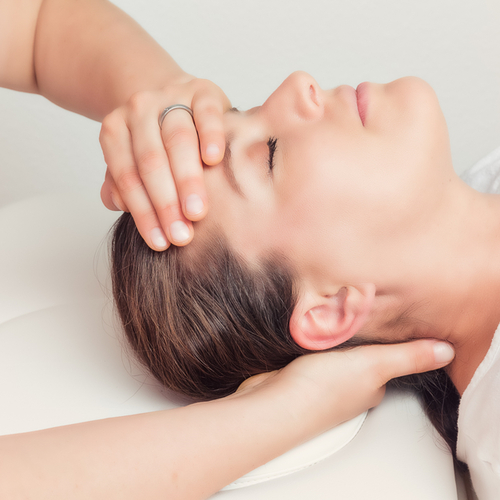
Craniosacral therapy
Alternate names: Approche Craniosacrale, Cranial Osteopathy, Cranial Therapy, Cranio-Occipital Technique, Craniosacral, Craniosacral Approach, Craniosacral Bodywork, Craniosacral Rhythm, Craniosacral System, Craniosacral Treatment, Craniosacrale Thérapie, CST, Ostéopathie Crânienne, Rythme Craniosacral, Système Craniosacral, Terapia Craneosacral, Thérapie Crânienne, Thérapie Craniosacrale, Thérapie Cranio-sacrée, Thérapie Cranio-sacrée Upledger, Traitement Craniosacral, Upledger Therapy
Background
Craniosacral therapy is a form of gentle massage therapy that focuses on the skull and the spine. It was developed by an American osteopath, Dr. John Upledger. Today, craniosacral therapy is used by massage therapists, chiropractors, naturopathy practitioners, and others. However, there are no consistent educational or practice standards for craniosacral therapy, and it is not a licensed or regulated practice in North America.
Craniosacral therapy is used for headache, migraine, back pain, neck pain, fibromyalgia, a group of painful conditions that affect the jaw joint and muscle (temporomandibular disorders or TMD), and many other conditions, but there is no good scientific evidence to support its use.
Craniosacral therapy is used for headache, migraine, back pain, neck pain, fibromyalgia, a group of painful conditions that affect the jaw joint and muscle (temporomandibular disorders or TMD), and many other conditions, but there is no good scientific evidence to support its use.
Safety Safety definitions
Craniosacral therapy is POSSIBLY SAFE when used appropriately by trained practitioners. Craniosacral therapy has been used in clinical trials for up to 20 weeks without adverse effects.
Brain injury: There are reports that craniosacral therapy might make symptoms of traumatic brain injury worse. Some people with brain injury have reported that craniosacral therapy worsened their head pain, nausea, vomiting, diarrhea, rapid heartbeat, psychiatric disturbances, and other symptoms.
Special Precautions & Warnings:
Pregnancy and breast-feeding: Craniosacral therapy is POSSIBLY SAFE during pregnancy and breast-feeding if used appropriately by trained practitioners.Brain injury: There are reports that craniosacral therapy might make symptoms of traumatic brain injury worse. Some people with brain injury have reported that craniosacral therapy worsened their head pain, nausea, vomiting, diarrhea, rapid heartbeat, psychiatric disturbances, and other symptoms.
Effectiveness
NatMed Pro rates effectiveness based on scientific evidence according to the following scale: Effective, Likely Effective, Possibly Effective, Possibly Ineffective, Likely Ineffective, Ineffective, and Insufficient Evidence to Rate.
Insufficient evidence Effectiveness definitions
- Back pain. Early research shows that craniosacral therapy might be just as beneficial as massage for improving low back pain.
- Excessive crying in infants (colic). Early research shows that craniosacral therapy might reduce crying and improve sleep in infants with colic.
- Fibromyalgia. Early research shows that craniosacral therapy might reduce pain and sensitivity of tender points in people with fibromyalgia.
- Neck pain. Early research shows that craniosacral therapy might reduce chronic neck pain in some people.
- Chronic pain. Some research suggests that craniosacral therapy might reduce pain in people with chronic pain due to migraine, tennis elbow, and other conditions.
- Pain in women who are pregnant. Early research shows that adding craniosacral therapy to standard therapy might improve pain and function in pregnant women with pelvic pain.
- Dizziness (vertigo). Early research shows that craniosacral therapy might improve balance and reduce dizziness in people with this condition.
- Headache.
- Migraine.
- Pain.
- Stress.
- Fatigue.
- A group of painful conditions that affect the jaw joint and muscle (temporomandibular disorders or TMD).
- Chronic fatigue syndrome (CFS).
- Spinal cord injury.
- Post-traumatic stress disorder (PTSD).
- Irritable bowel syndrome (IBS).
- Depression.
- "Slipped disks" in the spine.
- Autism.
- Learning disabilities.
- Other conditions.
Dosing & administration
The appropriate or safe use of craniosacral therapy depends on several factors such as the condition being treated or the person administering the treatment. Be sure to seek and follow relevant directions from your physician or other healthcare professional before using this treatment.
Interactions with pharmaceuticals
It is not known if this treatment interacts with any medicines. Before using this treatment, talk with your health professional if you take any medications.
Interactions with herbs & supplements
There are no known interactions with herbs and supplements.
Interactions with foods
There are no known interactions with foods.
Action
Craniosacral therapy is a form of massage therapy focusing on the skull and spine. Practitioners of craniosacral therapy believe that the bones of the skull are movable or that they can be manipulated in a way that treats a variety of medical conditions. Some practitioners believe that they can touch the head and become attuned to the patient's rhythm. They believe this connection results in improved energy flow, removal of energy blockages, or improved flow of cerebrospinal fluid for the patient.
vital.ly has licensed monographs from TRC Healthcare.
This monograph was last reviewed on 08/03/2024 11:00:00 and last updated on 11/09/2020 18:19:52. Monographs are reviewed and/or updated multiple times per month and at least once per year.
Natural Medicines disclaims any responsibility related to medical consequences of using any medical product. Effort is made to ensure that the information contained in this monograph is accurate at the time it was published. Consumers and medical professionals who consult this monograph are cautioned that any medical or product related decision is the sole responsibility of the consumer and/or the health care professional. A legal License Agreement sets limitations on downloading, storing, or printing content from this Database. No reproduction of this monograph or any content from this Database is permitted without written permission from the publisher. It is unlawful to download, store, or distribute content from this site.




